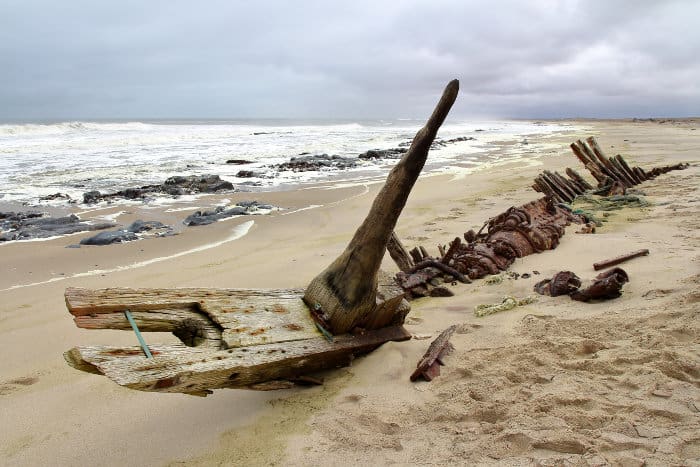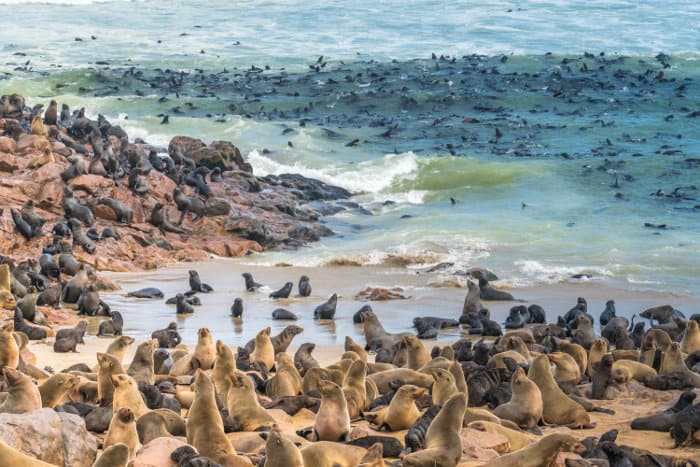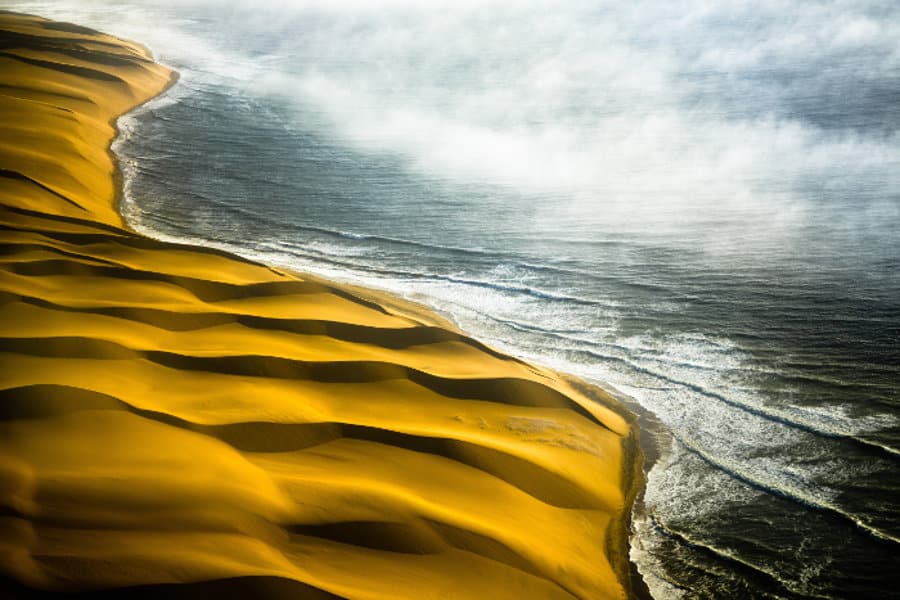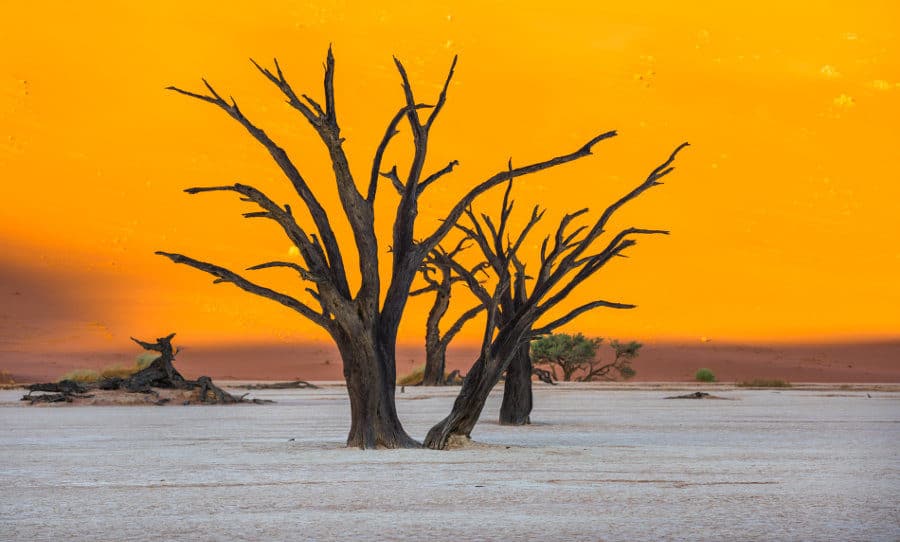There are few places on Earth where the desert meets the ocean. But along Namibia’s Skeleton Coast, the orange dunes of the Namib Desert give way to the cold, rough waters of the Atlantic Ocean.
The area is one of the most remote and sparsely populated places on the planet, and exudes an otherworldly atmosphere. Its bizarre, Martian landscapes contain towering dunes soaring high against the crisp blue sky. Each one topped by a fine, wind-carved ridge, snaking into the distance.
The skeleton coast is notorious for being harsh and desolate. Yet it’s one of the most beautiful places on Earth. And it’s an incredible place to visit for adventure seekers, animal lovers, historians, and photographers alike.
This guide offers insights into the elusive Skeleton Coast, as well as a breakdown of the best ways to visit it.
Tales of the Skeleton Coast: Shipwrecks and Bones

Namibia’s northwestern stretch of desert coastline has earned itself a range of formidable titles. Each one as deserved as the next. Early Portuguese sailors called it ‘The Sands of Hell’, while Namibia’s native Bushmen referred to it as ‘The Land God Made in Anger’.
However, it is best known by its official name: The Skeleton Coast. While the exact story behind this name is hazy, it’s not difficult to see why it stuck.
The ghostly remains of over 1,000 shipwrecks are strewn across the endless stretches of sand. These are the skeletons of ships driven ashore over the centuries by thick fog and infamous ocean currents.
The area is the world’s largest ship graveyard. With some of them buried deep in the dune-filled landscape, far from the foggy shore.
You can find the skeletons of their crews here, too. If sailors managed to survive a wreck, they found themselves trapped in the arid desert wilderness. Faced with 50°C heat, no water, and an infinite sea of dunes, most didn’t survive for long.
And if that isn’t enough to justify the name, you’ll also find animal bones peppering the desert. One can find gigantic whale rib bones and vertebrae half-buried, alongside the bones of desert dwellers. All bleached from the baking desert sun.
The area is alien and foreboding, and this is its charm. It’s so unfamiliar and desolate, that it challenges your ability to truly take it in. And it offers experiences that are unlike any others.
Where is the Skeleton Coast?
The Skeleton Coast stretches from the coastal town of Swakopmund in Namibia to the Kunene river at the Angolan border. It’s a protected area, 500 km long and about 40 km wide.
It forms part of the Namib Desert; one of the oldest and driest deserts in the world. Here, you’ll find some of the tallest sand dunes in existence – some reaching over 1,000 feet.
The Skeleton Coast National Park covers most of the broader Skeleton Coast area. It stretches from the Ugab River all the way to the northern reaches of Namibia. And it’s split roughly into two main sections.
The southern part of the coast is known as the National West Coast Recreation Area. While most refer to the Northern half of the park as the Skeleton Coast Wilderness.
Wildlife of the Skeleton Coast Desert

Such a hostile region doesn’t conjure images of flourishing wildlife. But the Skeleton Coast is home to a wide range of plant and animal life, adapted to withstand the harsh conditions. You’ll find all kinds of animals, big and small, who call the desert home.
From grey louries and Cape gannets to flamingoes and chestnut-banded plovers, birds are abundant in the area. As are insects and sand-dwelling reptiles like the Gerrhosaurus skoogi (Desert plated lizard). The ocean waters are rich with marine life, and at Cape Fria, you’ll find hundreds of thousands of Cape fur seals.
Larger animals have also settled in the depths of the desert, often gathering around the scarce watering holes and river beds. Among them, you’ll find giraffes, zebras, lions, gemsbok, springbok, black rhinoceros, hyenas, and the famed desert elephants.
Planning a Visit
Before you pack your bags and head for the Skeleton Coast, you’ll need to decide which parts you want to visit and what kind of experience you’d like to have.
There is plenty to see and experience along the southern portion of the Skeleton Coast. And it’s the place to go if you’re after an affordable, entry-level Namibian experience.
The real adventures, however, are in the northern section. And to explore this area, you’ll need to arrange a tour that makes use of a light aircraft. This option is more expensive, but it’s truly a once in a lifetime adventure.
Here’s a breakdown of both sections and how best to visit them.
Southern section – National West Coast Recreation Area

The southern half of the park stretches roughly between the Ugab and Hoanib rivers. It’s freely accessible to the public and you can access it by road. There are plenty of accommodation options here as well. So it’s a perfect destination for more casual travelers.
If you’re planning on visiting the southern stretch of the coast, you may choose to stay in or near the coastal city of Swakopmund. The city is a gateway to the Skeleton Coast and the Namib Desert.
Swakopmund is an excellent base for getting active. The city dubs itself the ‘activity hub of Namibia’ and offers a range of excursions. Among others, the activities available in the area include:
- Quad bike tours through the dunes
- Guided wildlife tours
- Horseback rides through the desert
- Swakopmund skydive adventures
- 4×4 desert safaris
- Sandboarding down the enormous dunes
- Scenic light aircraft flights along the coast
- Skeleton Coast surfing excursions
The area is also famous for its brilliant fishing conditions. And it offers some incredible riverbed hikes and self-drive safaris.
While you’re there, be sure to visit the Cape Cross Seal Reserve, to see the gigantic seal colonies. A visit here is an experience for all of the senses; the enormous mass of seals is a sight to behold, while their murmurs and bleats fill the airwaves.
Along with the pungent smell of guano. Visit them in November or December to see the newly born seal pups.
Northern section – Skeleton Coast Wilderness

The Northern section of the coast lies between the Hoanib and Kunene rivers, and is much harder to reach. But most people consider it the more attractive section for its untouched natural wonder, epic landscapes, and serene atmosphere.
One can reach it exclusively by light aircraft. And officials only grant access to certain tour operators with special permits.
With a tightly restricted number of permits available each year, the area is one of the most pristine stretches of coastline on Earth. And it offers an unimaginable experience.
The best way to explore the desolate northern reaches of the Skeleton Coast park is with a famous Schoeman family flying tour.
These multi-day Skeleton Coast tours take you by light aircraft to some of the most striking landscapes in the area.
You’ll drive through the desert in 4x4s, discover shipwrecks, and track wild game. As well as slide down roaring sand dunes and explore some incredibly remote destinations. All while hearing the stories and facts of the Skeleton Coast.
On these tours, you’ll experience true isolation. More often than not, you’ll be the only souls for many, many miles. You’ll camp out in a different place each night, with each camp striking and unique in its own right.
While these tours are not for the faint of heart or those on a budget, they offer something that is unique, awe-inspiring, and unforgettable.
Conservation and Respect
The Skeleton Coast is home to a delicate ecosystem that deserves the respect of all visitors. It’s a protected area for a reason, and you should treat it as such.
Stick to the areas and tracks that officials designate to visitors. And be sure that any quad-biking, 4x4ing, or other tour through the desert is arranged with reputable, qualified operators.
A Final Desert Whisper for the Skeleton Coast, Namibia

The Skeleton Coast is a place unlike any other. It’s an eerie, desolate region with an infamous history. Yet it’s also one of the most beautiful and incredible places to visit.
It offers remoteness that is scarce in our modern world. It boasts striking landscapes, unique scenes, epic activities, and a plethora of unlikely wildlife. It’s a reminder of a time before human civilization. And it’s a place that you’ll never forget.
If you’d like to experience the wonders of Africa for yourself, consider booking a tailor-made safari experience.



